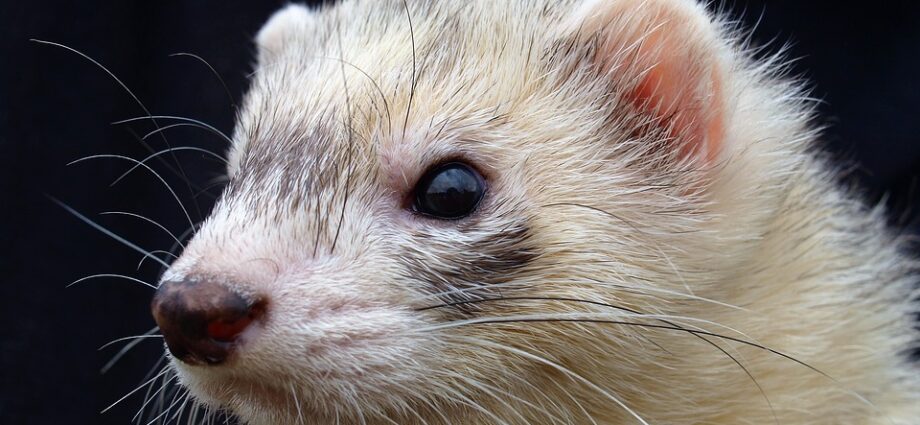The possibilities are you’ll observe it getting a yellow tint at least sometime in your ferret’s life if it is a while or light colored ferret. This is absolutely nothing to stress over and is a direct consequence of its natural oil production. Here are a few of the most common reasons your ferret’s coat might be turning yellow.
A white ferret may turn yellow for a wide range of reasons. A lot of these causes are straight connected to hormone imbalances that ferret’s of any sex or age might experience. Thus, they’re nothing considerable to worry about. Simply offer your little pal a bit of TLC and mindful grooming, and it’ll be simply fine.
On the other hand, the reason for your ferret’s yellow-colored tint might be connected to an illness impacting its adrenal gland. Here’s a more detailed look at what might be triggering your ferret’s strange appearance.
A white ferret with a little bit of a yellow tint on its fur sits under the running faucet of a filling sink.
1. Hyper Oil Glands
Overactivity in the oil glands is without a doubt the most typical reason that a ferret may turn yellow. This is a natural event that can take place to any ferret, regardless of its health or age.
A ferret’s sebaceous glands produce a liquid substance that can be either thick or thin, and in both cases, yellow in coloration. These glands exist all over the body, including the rectum, so your ferret’s entire body can turn yellow when it’s producing excessive oil.
As the oil collects on the ferret’s skin, it “spots” its white fur, in a sense, effectively tinting the ferret’s entire body. Some of the most likely explanations for why your ferret’s sebaceous glands are entering into overdrive include:
Seasonal shifts: Oils are mammals’ natural technique of cooling off the body and securing the skin from the extreme environment. Throughout seasonal shifts, specifically moving into warmer weather, you may discover that your white ferret’s coat is yellowing.
Overbathing: Oil is likewise important in waterproofing the skin. Its physiological response is to renew the loss of natural oils considering that the shampoos have actually removed it all away if you’ve been bathing your ferret too often.
Dietary modifications: Switching up your ferret’s diet plan can also trigger imbalances in their hormones, which can eventually lead to abnormally high oil production levels. High-fat diet plans affect the liver, leading to sebaceous gland imbalances.
Before you get too concerned about your now-yellow ferret, reflect on any changes you might have just recently made to your care routine. Have you offered your ferret an extra bath lately, or did you just start your ferret on a new food? These are the most probable causes of your ferret’s yellowing if so.
In these cases, you simply need to adjust your grooming and feeding strategy to enable your ferret to restore its physiological balance.
2. Yellow Fur Due to Mating Season
Its oil glands can end up being excessively stimulated due to a significant shift in its internal hormonal balance if your ferret is not de-sexed. This holds true for both males and females, so it’s important that you have your ferret de-sexed no matter what.
Still, exactly what does this relate to yellowing? As pointed out previously, the oil your ferret’s glands excrete has a yellow tint. Sadly, this exact same oil is responsible for its musky odor, which plays a critical role in ferret breeding.
If your ferret is not de-sexed, this is just among the many factors to take it to the vet for that treatment straight away. In addition, for females, overlooking to de-sex your ferret can lead to possibly deadly complications, including:
3. Yellow Fur Due to Adrenal Disease
Adrenal disease is most likely to affect older ferrets, specifically those between 3-7 years old. This is carefully related to the reason for yellowing listed above, sexual maturity. Ferrets that remain in season experience a peak in the production of their sex hormonal agents, which leads to an increase in the adrenal gland’s size.
If this procedure goes too far, it can cause a condition known as “hyperplasia,” meaning the adrenal gland is dangerously big and is at threat of shaking off the ferret’s normal hormone concentrations.
Honestly, yellow fur is among the least common symptoms that can emerge from adrenal illness. The result you’re most likely to observe is that your ferret loses all its hair entirely, among other main indications, including:
Dry, scratchy skin
Anemia
Aggressiveness (due to pain or pain).
Urinary problems.
Some ferret owners are understandably careful of getting their male ferrets desexed. Regrettably, neutering has actually been connected to an increased risk of adrenal illness for males given that the brain continues signaling the testicles to produce sex hormonal agents without the capability to stop it, producing a “negative feedback loop.”.
To assist this, vets use chemical castration implants like Suprelorin ® or injections such as Lupron ® to keep desexed ferrets happy and healthy.
Keep in mind that these complications are possible for female ferrets, too. Nevertheless, since females face higher health risks without desexing, these discussions tend to concentrate on males.
Summary.
It’s relatively common for a white ferret to turn yellow due to natural oil production issues. The most common factors consist of seasonal changes, overbathing, dietary issues, and physiological changes due to mating season. Nevertheless, it could be a more extreme problem like adrenal disease.
Observe all the indications that your ferret is showing to identify whether the change requires a veterinary check out. If you’re unsure, it’s best to speak with a vet anyhow. Although yellowing isn’t usually something to get too worried over, that’s the best way to guarantee your ferret’s health.

